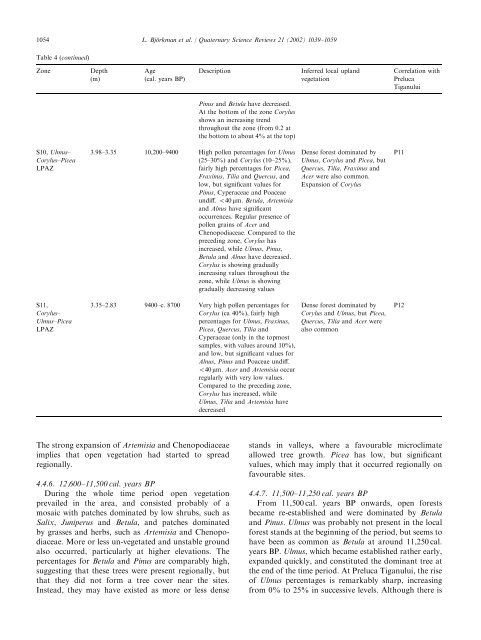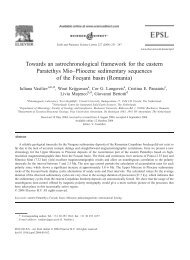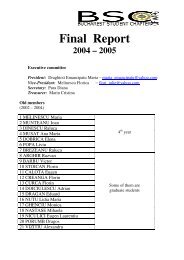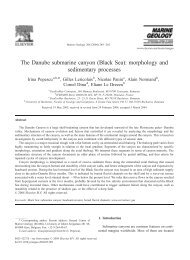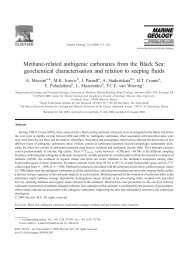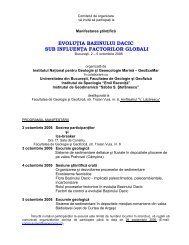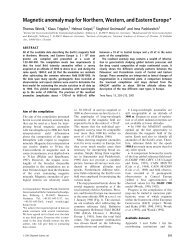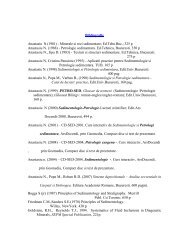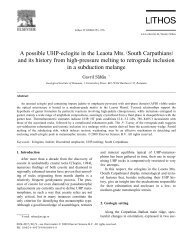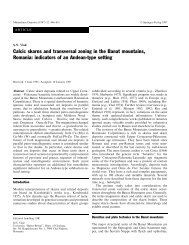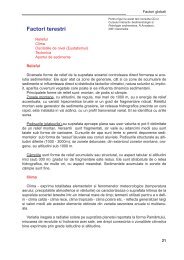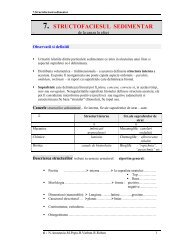Lateglacial and early Holocene vegetation ... - geo.edu.ro
Lateglacial and early Holocene vegetation ... - geo.edu.ro
Lateglacial and early Holocene vegetation ... - geo.edu.ro
You also want an ePaper? Increase the reach of your titles
YUMPU automatically turns print PDFs into web optimized ePapers that Google loves.
1054<br />
L. Bj .orkman et al. / Quaternary Science Reviews 21 (2002) 1039–1059<br />
Table 4 (continued)<br />
Zone<br />
Depth<br />
(m)<br />
Age<br />
(cal. years BP)<br />
Description<br />
Inferred local upl<st<strong>ro</strong>ng>and</st<strong>ro</strong>ng><br />
<st<strong>ro</strong>ng>vegetation</st<strong>ro</strong>ng><br />
Correlation with<br />
Preluca<br />
Tiganului<br />
Pinus <st<strong>ro</strong>ng>and</st<strong>ro</strong>ng> Betula have decreased.<br />
At the bottomof the zone Corylus<br />
shows an increasing trend<br />
th<strong>ro</strong>ughout the zone (f<strong>ro</strong>m0.2 at<br />
the bottomto about 4% at the top)<br />
S10, Ulmus–<br />
Corylus–Picea<br />
LPAZ<br />
S11,<br />
Corylus–<br />
Ulmus–Picea<br />
LPAZ<br />
3.98–3.35 10,200–9400 High pollen percentages for Ulmus<br />
(25–30%) <st<strong>ro</strong>ng>and</st<strong>ro</strong>ng> Corylus (10–25%),<br />
fairly high percentages for Picea,<br />
Fraxinus, Tilia <st<strong>ro</strong>ng>and</st<strong>ro</strong>ng> Quercus, <st<strong>ro</strong>ng>and</st<strong>ro</strong>ng><br />
low, but significant values for<br />
Pinus, Cyperaceae <st<strong>ro</strong>ng>and</st<strong>ro</strong>ng> Poaceae<br />
undiff. o40 mm. Betula, Artemisia<br />
<st<strong>ro</strong>ng>and</st<strong>ro</strong>ng> Alnus have significant<br />
occurrences. Regular presence of<br />
pollen grains of Acer <st<strong>ro</strong>ng>and</st<strong>ro</strong>ng><br />
Chenopodiaceae. Compared to the<br />
preceding zone, Corylus has<br />
increased, while Ulmus, Pinus,<br />
Betula <st<strong>ro</strong>ng>and</st<strong>ro</strong>ng> Alnus have decreased.<br />
Corylus is showing gradually<br />
increasing values th<strong>ro</strong>ughout the<br />
zone, while Ulmus is showing<br />
gradually decreasing values<br />
3.35–2.83 9400–c. 8700 Very high pollen percentages for<br />
Corylus (ca 40%), fairly high<br />
percentages for Ulmus, Fraxinus,<br />
Picea, Quercus, Tilia <st<strong>ro</strong>ng>and</st<strong>ro</strong>ng><br />
Cyperaceae (only in the topmost<br />
samples, with values a<strong>ro</strong>und 10%),<br />
<st<strong>ro</strong>ng>and</st<strong>ro</strong>ng> low, but significant values for<br />
Alnus, Pinus <st<strong>ro</strong>ng>and</st<strong>ro</strong>ng> Poaceae undiff.<br />
o40 mm. Acer <st<strong>ro</strong>ng>and</st<strong>ro</strong>ng> Artemisia occur<br />
regularly with very low values.<br />
Compared to the preceding zone,<br />
Corylus has increased, while<br />
Ulmus, Tilia <st<strong>ro</strong>ng>and</st<strong>ro</strong>ng> Artemisia have<br />
decreased<br />
Dense forest dominated by<br />
Ulmus, Corylus <st<strong>ro</strong>ng>and</st<strong>ro</strong>ng> Picea, but<br />
Quercus, Tilia, Fraxinus <st<strong>ro</strong>ng>and</st<strong>ro</strong>ng><br />
Acer were also common.<br />
Expansion of Corylus<br />
Dense forest dominated by<br />
Corylus <st<strong>ro</strong>ng>and</st<strong>ro</strong>ng> Ulmus, but Picea,<br />
Quercus, Tilia <st<strong>ro</strong>ng>and</st<strong>ro</strong>ng> Acer were<br />
also common<br />
P11<br />
P12<br />
The st<strong>ro</strong>ng expansion of Artemisia <st<strong>ro</strong>ng>and</st<strong>ro</strong>ng> Chenopodiaceae<br />
implies that open <st<strong>ro</strong>ng>vegetation</st<strong>ro</strong>ng> had started to spread<br />
regionally.<br />
4.4.6. 12,600–11,500 cal. years BP<br />
During the whole time period open <st<strong>ro</strong>ng>vegetation</st<strong>ro</strong>ng><br />
prevailed in the area, <st<strong>ro</strong>ng>and</st<strong>ro</strong>ng> consisted p<strong>ro</strong>bably of a<br />
mosaic with patches dominated by low shrubs, such as<br />
Salix, Juniperus <st<strong>ro</strong>ng>and</st<strong>ro</strong>ng> Betula, <st<strong>ro</strong>ng>and</st<strong>ro</strong>ng> patches dominated<br />
by grasses <st<strong>ro</strong>ng>and</st<strong>ro</strong>ng> herbs, such as Artemisia <st<strong>ro</strong>ng>and</st<strong>ro</strong>ng> Chenopodiaceae.<br />
More or less un-vegetated <st<strong>ro</strong>ng>and</st<strong>ro</strong>ng> unstable g<strong>ro</strong>und<br />
also occurred, particularly at higher elevations. The<br />
percentages for Betula <st<strong>ro</strong>ng>and</st<strong>ro</strong>ng> Pinus are comparably high,<br />
suggesting that these trees were present regionally, but<br />
that they did not forma tree cover near the sites.<br />
Instead, they may have existed as more or less dense<br />
st<st<strong>ro</strong>ng>and</st<strong>ro</strong>ng>s in valleys, where a favourable mic<strong>ro</strong>climate<br />
allowed tree g<strong>ro</strong>wth. Picea has low, but significant<br />
values, which may imply that it occurred regionally on<br />
favourable sites.<br />
4.4.7. 11,500–11,250 cal. years BP<br />
F<strong>ro</strong>m11,500 cal. years BP onwards, open forests<br />
became re-established <st<strong>ro</strong>ng>and</st<strong>ro</strong>ng> were dominated by Betula<br />
<st<strong>ro</strong>ng>and</st<strong>ro</strong>ng> Pinus. Ulmus was p<strong>ro</strong>bably not present in the local<br />
forest st<st<strong>ro</strong>ng>and</st<strong>ro</strong>ng>s at the beginning of the period, but seems to<br />
have been as common as Betula at a<strong>ro</strong>und 11,250 cal.<br />
years BP. Ulmus, which became established rather <st<strong>ro</strong>ng>early</st<strong>ro</strong>ng>,<br />
exp<st<strong>ro</strong>ng>and</st<strong>ro</strong>ng>ed quickly, <st<strong>ro</strong>ng>and</st<strong>ro</strong>ng> constituted the dominant tree at<br />
the end of the time period. At Preluca Tiganului, the rise<br />
of Ulmus percentages is remarkably sharp, increasing<br />
f<strong>ro</strong>m0% to 25% in successive levels. Although there is


